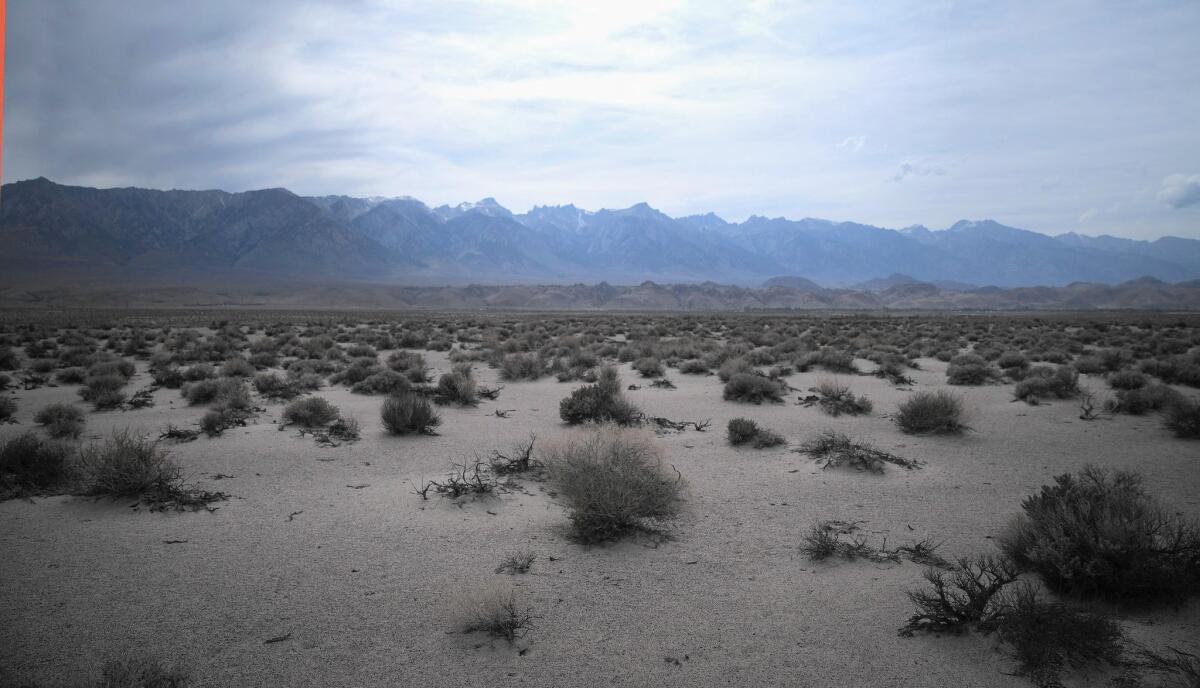Owens Valley ranchers and environmentalists brought together by drought

Reporting from Olancha â The drought has worked a miracle in the Owens Valley, as environmental activists and ranchers have buried decades of enmity to forge a plan to save ranch land â at the expense of hard-fought environmental protections.
The two sides began talking after the DWP announced plans last month to slash irrigation allotments for half of Inyo Countyâs 50 ranches. The utility said the cuts are necessary because the Sierra snowpack, which typically provides a large share of DWPâs water for Los Angeles, is just 4% of normal â not enough to irrigate all ranches and meet DWPâs environmental obligations in the valley.
If the ranches go dry, the owners will lose their livestock at the same time as the natural habitat on their property succumbs to drought. Environmentalists say the loss of habitat would be disastrous to wildlife and vegetation in the valley, 200 miles north of Los Angeles.
So to preserve the ranches, environmentalists have agreed to curtail water diversions for restoration of the Lower Owens River and controlling dust on dry Owens Lake, which were drained after construction of the Los Angeles Aqueduct in 1913.
âWe were driven into each othersâ arms by the DWP,â said Mike Prather, a longtime environmental activist.
The new alliance, however transitory, defies decades of battle between the two sides.
Environmentalists have long believed the local mountains would be better off without cattle trampling stream banks, polluting creeks with animal waste and eroding fragile meadows with intensive grazing.
A decade ago, ranchers used their formidable political influence to derail a proposed conservation easement that would have forever banned development on about 500 square miles of Owens Valley land owned by DWP. The ranchers feared that environmentalists were angling for management plans that would limit their century-old grazing privileges on that land.
But the old enemies found common ground after snowpack surveys in April led DWP to announce that starting May 1, it would provide only 20,500 acre-feet of irrigation water to ranches instead of the usual 49,000 acre-feet.
The announcement caused an uproar. Inyo County threatened to seek an injunction to stop what it claimed was a violation of long-term water agreements with ranchers that would devastate the local economy. Farming and ranching generate $20 million a year in Inyo County, second only to tourism, officials said.
âIt was a direct attack on the Owens Valley economy,â Inyo County Administrator Kevin Carunchio said.
The DWP swiftly abandoned the May 1 deadline and ranchers began talking with their long-time foes.
âMy agenda is to sustain my operation and family income,â said Mark Lacey, an Owens Valley rancher. âEnvironmentalists want to protect wildlife. We can accomplish both by preserving ranches.â
Mary Roper, president of a conservation group known as the Owens Valley Committee, said the organization has been âbuilding an alliance with ranchers â our friends and neighbors.â
As a result, the regionâs air pollution agency and the DWP have agreed that ranchers will get about 3% of the roughly 60,000 acre-feet of water it uses each year to flood portions of the Owens Lake bed to control choking dust storms that had plagued the valley and to provide a gathering place for migrating birds and waterfowl. An acre-foot of water is enough to supply two households for a year.
The Great Basin Unified Air Pollution Control District is still in negotiations with the DWP that might lead to more diversion.
Among other proposals under consideration is one to send ranchers about a third of the aqueduct water that is diverted annually into the Lower Owens â the largest river habitat restoration project ever attempted in the West.
The utility agreed in 1991 to restore the Lower Owens after groundwater pumping by the DWP between 1970 and 1990 destroyed habitat in the Owens Valley. It took 15 years of court battles, however, before any aqueduct water was redirected into the channel and the 62-mile-long Lower Owens rippled anew.
State wildlife authorities believe the proposal would not harm recovering populations of bass and other fish in the river. Some environmentalists, however, worry it could result in less oxygen for aquatic species, possibly triggering fish die-offs.
Temporarily reducing the flow would require unanimous agreement among the six stakeholders that signed the Lower Owensâ memorandum of understanding: the Sierra Club, the Owens Valley Committee, the California Department of Fish and Wildlife, the California State Lands Commission, Inyo County and long-time environmental activist Carla Scheidlinger. It would also need approval from an Inyo County Superior Court judge.
Water wars have defined the 110-mile Owens Valley since the early 1900s, when Los Angeles city agents posed as ranchers and farmers to buy land in the area and obtain the water rights. Their goal was to build the aqueduct system needed to meet the needs of the growing metropolis.
The regionâs economy and wildlife have struggled ever since in a stunning landscape of snowcapped peaks, cascading streams, dormant volcanoes and sage plains dotted with irrigated pastures and alfalfa fields.
The long drought and this yearâs tiny snowpack means that for the first time since the aqueduct was built, no Owens Valley water will flow to Los Angeles. The stoppage is expected to last until November, when the irrigation season ends.
This weekâs late-season storm could not have come soon enough for Bill Talbot, who runs 500 head of cattle on 1,250 acres about 10 miles north of Bishop.
âA lot of people think all this green grass is natural,â Talbot said, while inspecting the latticework of creek-fed ditches in his browning pastures. âWithout irrigation, itâd be nothing but sage flats.â
Lacey, who leases 33,000 acres from DWP in Owens Valley, is among several ranch owners reducing their herds by sending cattle to Idaho, Wyoming and Nebraska.
âItâs costly to move cows,â said Lacey, whose ancestors settled in the Owens Valley more than 130 years ago. âBut water for environmental projects have become more valuable than ranching operations.â







